If you enjoy making your own condiments from seasonal produce, this soft set Grapefruit Marmalade is for you. Marmalade is a favoured preserve on many breakfast tables. It is easy to appreciate that this zesty, tangy preserve is a great way to start the day.
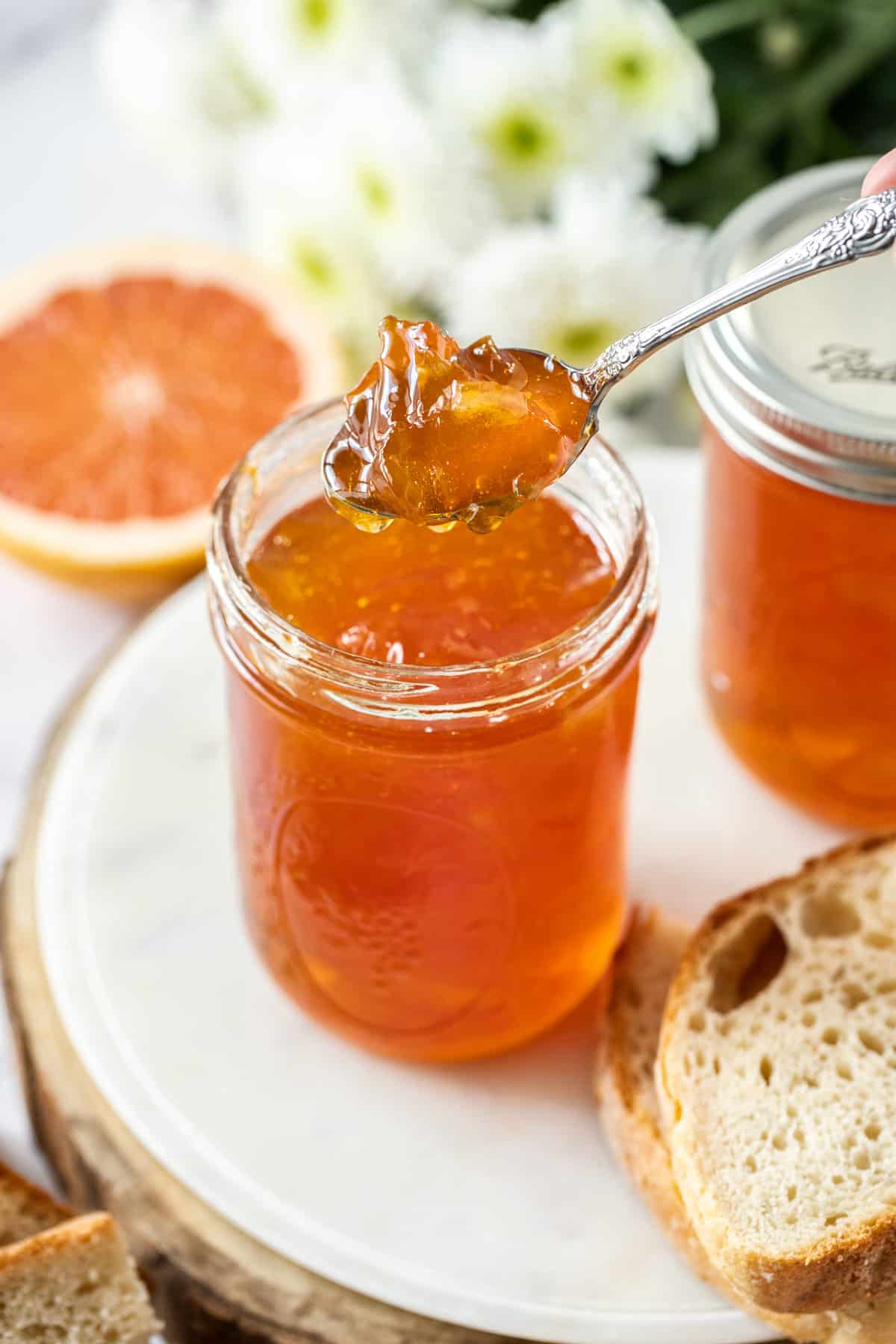
Why we love this recipe:
This recipe is a very special family recipe - handed down to me by my great great grandmother! So, it's a few years old.. but oh so delicious!
There are few things more satisfying than taking fresh, locally grown produce and transforming it into something delicious which can be used in the months ahead. Making marmalade is one way to preserve some of winter's bounty.
I regard homemade jams and spreads as luxury items. It's not that they are expensive to make, especially when the fruit is a gift, but there is an investment of time.
However, having jars of marmalade that you have made yourself is tremendously satisfying. The flavours are bright and clear and remember, there are just four ingredients. Compare that with the labels of some commercial varieties which often have a large range of additives.
A little effort and time will produce a wonderful array of jars filled with this soft set Grapefruit Marmalade, some of which I will keep for myself and many of which I will give away to friends as a special homemade treat.
If you think that making marmalade is difficult, I want to assure you that it is easier than you may think. Although there is a great deal of science involved, it just requires that you follow a few simple steps and we will happily guide you through the process.
This is a classic method of making marmalade. It requires just four ingredients, and one of them is water. That is all that you need to make this fresh-flavoured condiment. It produces a soft set Marmalade; it will not be as firm as many commercial varieties which often contain additives.
Ingredients in this recipe:
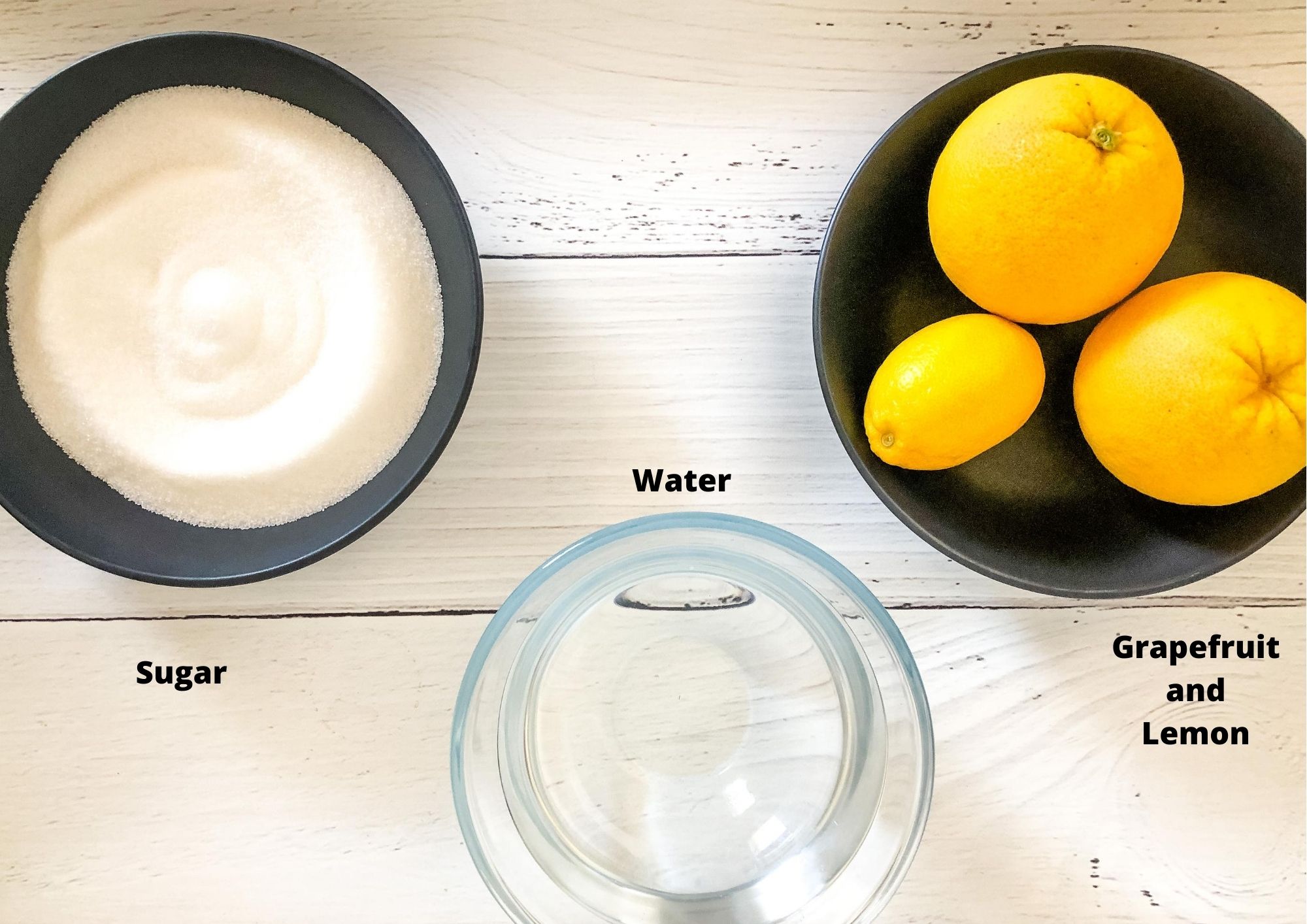
Please see the recipe card further along in the post for exact quantities of ingredients and the full method.
Grapefruit - I prefer to use homegrown or organic fruit which does not have a wax coating.
Lemon - again, my preference is homegrown or organic fruit without wax.
Sugar - use regular granulated white sugar. Do not be concerned by the amount of sugar - this is correct. This recipe uses a higher quantity of water. See the notes in the recipe card.
Water - I use filtered tap water.
Step by Step Instructions:
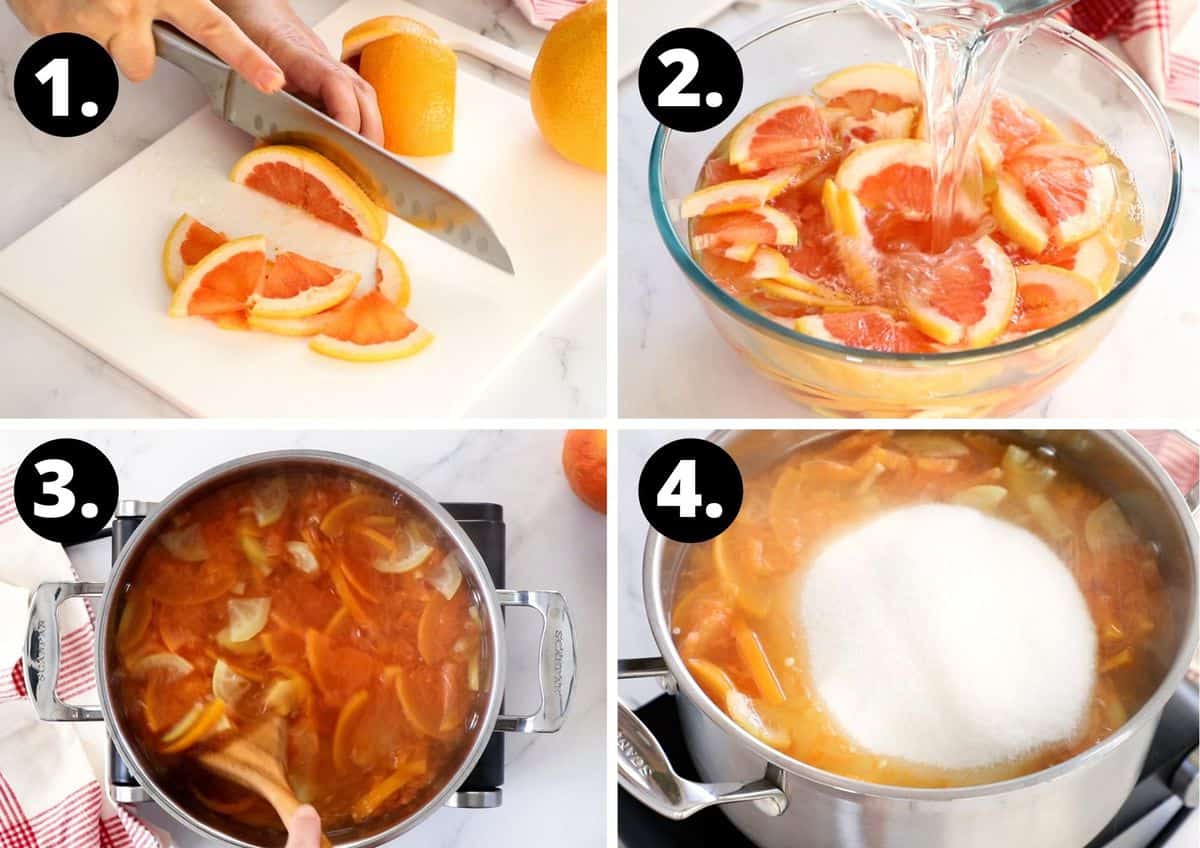
Making the Grapefruit Marmalade is a two-day process. To begin, I wash the fruit.
- Cut the grapefruit and lemon into quarters and finely slice them, removing any seeds that I may find.
- I place the fruit into a non-reactive bowl, add the water, cover the bowl and set aside overnight. Soaking the fruit serves two purposes. Firstly, it softens the peel and secondly, it helps release the pectin required for setting the jam.
- On day two, you add the fruit and water to a large saucepan and cook to soften the peel.
- Then, add the sugar.
- Start to test after about 10 minutes to ensure you don't go past setting point. See the recipe card and instructions for more information.
- Spoon some marmalade onto a cold saucer.
- You can use the wrinkle test to check setting point, or, use a candy thermometer to ensure accuracy (see the recipe card for more details.)
- Once setting point is reached, take off the heat and allow to sit for 10 minutes. This will help the fruit to settle and evenly distribute when poured into the jars. Without settling, the fruit will rise to the top of the marmalade. And finally, ladle it into sterilized jars.
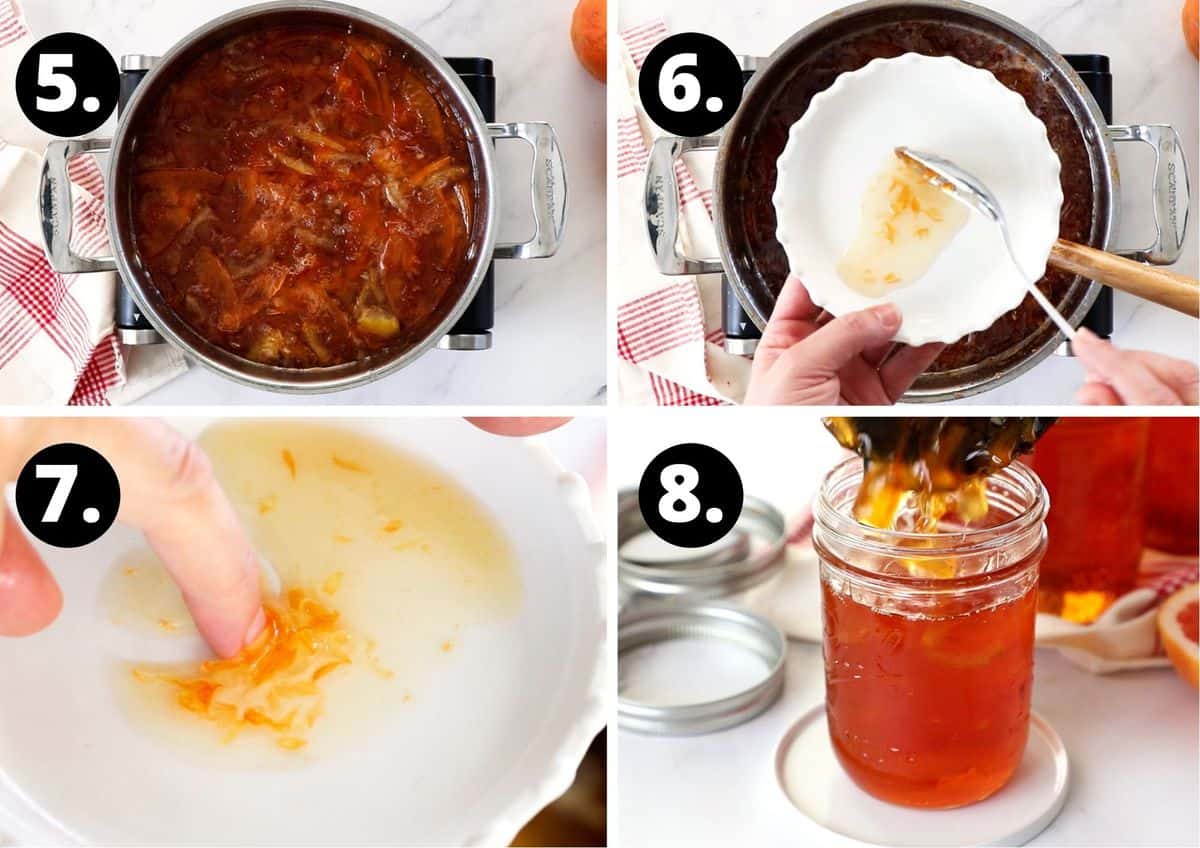
Tips for success and FAQs:
When making your own preserves, always ensure you are sterilising the jars you will store them in. This is very simple to do:
- Choose glass jars with an airtight, metal lid and ensure they have been washed by hand in hot soapy water then rinsed well.
- Check that the metal lids do not have rubber inserts.
- Preheat the oven to 130 Degrees C (270 F) and leave the jars for 15-20 minutes.
You will need to prepare the ingredients for the Grapefruit Marmalade a day ahead. We soak the peel overnight; this helps develop the pectin which assists with setting the marmalade. Also, the fruit will soften and this means it will take less time to cook; a shorter cooking will produce a brighter, fresher-flavoured marmalade.
You will not need any special equipment to make this recipe. However, a large saucepan is essential. When you add the sugar, it foams up enormously. Without a very large saucepan, there is the risk of it boiling over. I also like to use a long-handled wooden spoon to keep my hand away from the bubbling marmalade. Do not use a metal spoon, it will become very hot. Whilst a jam/candy thermometer is not essential, it can be valuable to precisely determine setting point.
This may seem an excessive amount of sugar, however, this is not the usual fruit to sugar ratio which is used in jam making. For the marmalade we use a large amount of water to soak the fruit. The water is included in the marmalade so this means a larger amount of sugar.
When making marmalade and jams, the sugar is not just a sweetener, it also assists with gelling and preservation. Therefore, I don't recommend reducing the amount of sugar as it may interfere with the setting and preservation. The sugar is an important component in making the jam shelf-stable.
Citrus fruits are high in pectin so it is not necessary to use jam sugar. Regular granulated sugar is all that is required.
To achieve the best result, you will need to prepare the ingredients for the Grapefruit Marmalade a day ahead. We soak the peel overnight; this helps develop the pectin which assists with setting the marmalade. Also, the fruit will soften and this means it will take less time to cook; a shorter cooking will produce a brighter, fresher-flavoured marmalade.
No, it is not necessary to refrigerate it, just store it in a cool, dark place. When cooked to setting point and poured into sterilised jars the marmalade will keep for at least 12 months. I do, however, store a jar in the refrigerator after it has been opened.
As we are using the whole fruit, it is best to use organic or home-grown fruit. However, if you are only able to access commercially grown fruit, they need to be thoroughly cleaned.
Always use fruit which is in good condition and ideally some which are slightly under-ripe as they will contain more pectin. Bruised or damaged fruit may spoil the jam, causing it to deteriorate quickly.
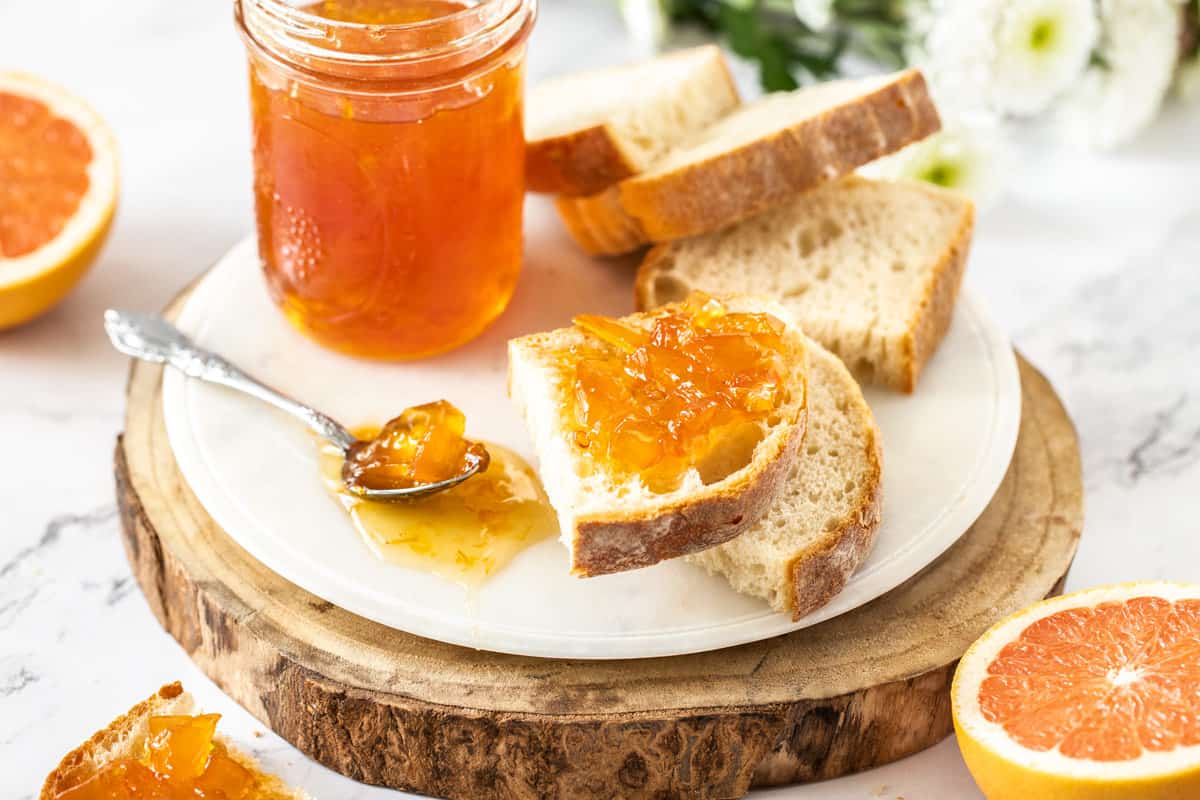
How do I know if my Marmalade has reached setting point?
These are two ways you to check if your Marmalade has reached setting point.
- You can use the "wrinkle test", as outlined in the recipe;
- If you don't feel confident, or are not an experienced Marmalade maker, I recommend the fail safe method of using a jam/candy thermometer to indicate setting point.
Your marmalade will be very liquid when you add it to the jars so please don't be concerned. It will continue to thicken as it cools.
Leave it for 24 hours and then check again. If it is still runny, you can re-boil the marmalade. Empty the contents of the jars back into the saucepan and bring to a boil. To increase the pectin and help the marmalade to set, you can add the juice of half a lemon. Boil for a few minutes and test again.
However, if the marmalade was initially boiled too long, it can still result in it not setting as the pectin may have been damaged, and therefore, reboiling the marmalade will not help.
When setting point is reached, as outlined in the recipe instructions, it is important to remove the saucepan from the heat and set it aside for 10 minutes. This will help the fruit to settle and evenly distribute when poured into the jars. Without settling, the fruit will rise to the top of the marmalade.
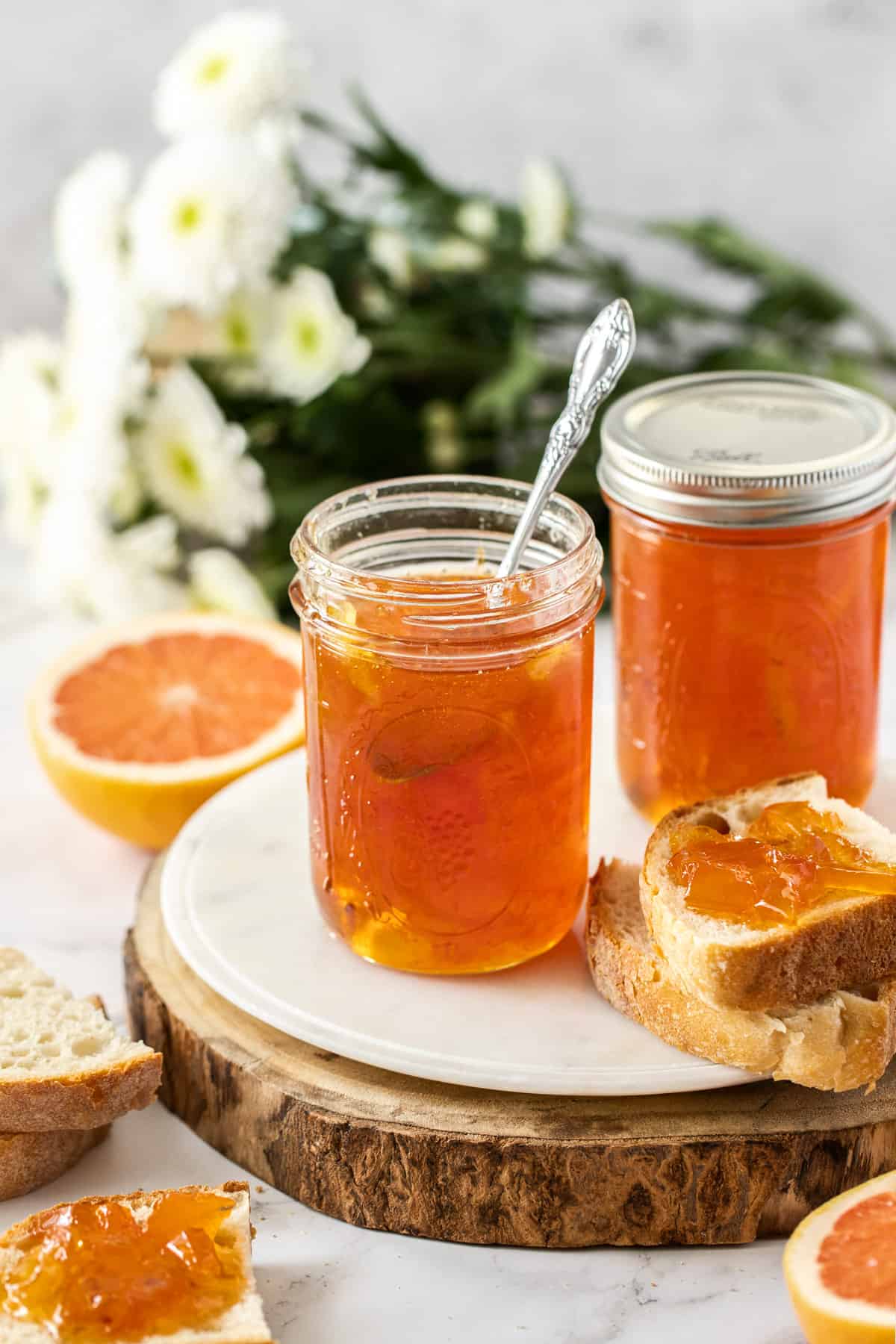
When it comes to serving:
Marmalade is a popular condiment, perhaps best known as a spread for toast at breakfast time. However, don't be limited by the thought that marmalade is only eaten at breakfast. There are many more ways to use it.
- A sticky glaze for chicken drumsticks;
- Make a sauce for pork tenderloin;
- Glaze a Christmas ham;
- Use it in a marinade for chicken;
- Make crostini with goat cheese and prosciutto;
- Bake a lemon cake and make a glaze with the marmalade;
- Add it to the top of a baked brie.
More delicious condiments and edible gift ideas:
- Preserved Chillies in Oil
- Dill Pickled Cucumbers
- Apricot Jam
- Plum Jam
- Japanese Pickled Ginger (Gari)
- Fresh Peach Chutney
- Sweet Chilli Sauce
- Balsamic Glaze
- Pickled Daikon
- Beetroot Pickled Turnips
- Spicy Pickled Cucumbers
- Lemon Marmalade
- Classic Lemon Curd
- Blood Orange Curd
When you try this lovely Grapefruit Marmalade you will realise that there is no comparison between homemade marmalade and the commercially produced varieties.
Do let me know in the comments below when you have tried this delicious recipe.
Alex xx
This post was originally published in August 2020. It has been updated with new photos, a video and more information. The recipe has been slightly altered to make a smaller batch.
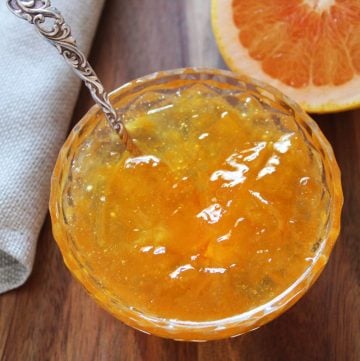
Grapefruit Marmalade
Please note:
For accuracy, when weights are provided, we recommend weighing your ingredients. This will produce the best results. All oven temperatures listed are for fan forced.
Ingredients
- 500 g (1 lb) grapefruit - prepared weight See Notes 1 and 2
- 1 large lemon
- 6 cups (1.5 Litre) water
- 8 cups (1.8 kg) sugar See Note 3
Instructions
Please Read First:
- Preserve making is quite simple, but we do recommend reading the recipe through first and following these tips:- weigh your ingredients for accuracy.- do not double the recipe or alter the quantities.- yes, it’s a lot of sugar. It’s also a lot of water. When making marmalade, the sugar is not just a sweetener, it also assists with gelling and preservation. When prepared properly, your end result will be the perfect mix of sweet, citrus tang and bitter, as marmalade should be. This is an old-fashioned recipe (my great great grandmothers.) - use a very large saucepan as the marmalade needs to rapidly boil and will foam up and you don’t want it to overflow.- ensure the marmalade reaches setting point. Keep in mind the marmalade will be very liquid while hot. Do not over boil as you will risk burning the marmalade.- allow 24-48 hours once jarred for the pectin to activate and the marmalade to set properly.- if after this time your marmalade hasn’t set, it likely wasn’t cooked for long enough initially. In this case, add the marmalade back to a clean saucepan with the juice of a fresh lemon. Bring back to the boil and start testing after 5 minutes of rapid boiling.
To Sterilise the Jars:
- Sterilise the jars you'll be using to store the marmalade.Choose glass jars with an airtight, metal lid and ensure they have been washed in the dishwasher or by hand in hot soapy water then rinsed well.Check that the metal lids do not have rubber inserts. (See Note 9)Preheat the oven to 130 Degrees C (270 F) and place the jars in the oven for 15-20 minutes.
For the Marmalade:
- Place 2 saucers or small plates in the freezer, ready to check for the setting point of your marmalade.Thoroughly wash the grapefruit and lemon. Remove each end of the grapefruit to get rid of excess pith. Remove each end of the lemon. Cut the grapefruit and lemon into quarters length ways. Holding two of the quarters together, slice as thinly as possible and remove any seeds.
- Place the citrus slices in a non-reactive bowl. See Note 4. Add the 6 cups of water, cover the bowl and leave the fruit to stand overnight, up to 24 hours. If your bowl is not large enough to accommodate all the water, add what you can and add the remainder the following day. It's best to make a note of what you have added.The following day, place the fruit and water into a very large, non-reactive saucepan. - See Note 5.
- Over medium-high heat, bring the fruit and water to the boil. Rapidly boil for approximately 15 minutes or until the peel is tender, stirring occasionally with a long-handled wooden spoon - See Note 6.
- Add the sugar and stir well to dissolve it. After dissolving the sugar, return the fruit to the boil, stirring occasionally. Continue to stir until the marmalade reaches setting point - I start to check at about 10 minutes. When the very aggressive bubbles subside to a slower, gentler boil, that's an indication that your marmalade may have reached setting point - See Note 7.Remove from the heat to conduct the wrinkle test. If not set, continue to boil for another 1 minute and then test again.
- To test for setting point, I use the "wrinkle" test. Take one of your saucers from the freezer and pour a small amount of marmalade onto it. Let it cool for a minute then push against the marmalade with the tip of your finger. If the surface wrinkles slightly, it means setting point has been reached.Alternatively, if you are not confident checking this way or are not experienced at making marmalade, you can use the fail-safe method of using a jam/candy thermometer which you clip to the side of your saucepan. When attaching your thermometer, make sure that the base is not touching the bottom of the saucepan. Your marmalade has reached setting point when the temperature reaches 104.5 degree C or 220 degrees F. (Taking it much higher than this will result in the marmalade being overboiled, the pectin being destroyed, and therefore, your marmalade will not set.)At this time, your marmalade will look very liquidy - it can take 24-48 hours to completely cool and set.Please note, this recipe will produce marmalade which has a soft set; it will not be as firm as many commercial varieties which often contain additives.
- Take the mixture off the heat. If there is any scum on the marmalade, add a teaspoon of butter and stir; that should settle the scum.
- Let the marmalade stand for about 10 minutes to allow the fruit to settle. If you bottle it immediately, the fruit will not be evenly distributed but will settle at the top of the jar.
- Remove your jars from the oven and carefully ladle the marmalade into the heated, sterilised jars. The jars should be filled as full as possible to minimise the amount of air between the marmalade and the lid. The marmalade should not touch the lid. Seal tight once filled with marmalade. See Note 8You need to be very careful. Splashing yourself with hot marmalade will result in a very serious burn. I suggest you have clothing with long sleeves and ensure that you do not have children nearby.
Video
Notes
- I used 2 medium-large grapefruit to achieve the weight after the ends and seeds have been removed.
- As the peel is such an important part of the marmalade, I like to use organic or home-grown citrus. Commercially produced grapefruit and lemons generally have a wax coating and may have been sprayed with something toxic. If this is all that you can obtain, you can clean the grapefruit and lemons by placing them in a colander and pouring over freshly boiled water. Then, scrub them gently with a nail brush while holding them under cold running water.
- This may seem an excessive amount of sugar, however, this is not the usual fruit to sugar ratio. We use a large amount of water to soak the fruit. The water is included in the marmalade.so this means a larger amount of sugar.
- Non-reactive bowls and saucepans are stainless steel, glass, ceramic or enamelled cookware. Aluminium, copper and iron bowls or pans are reactive. Acidic foods, such as citrus, may discolour and take on a metallic taste if these are used.
- A large saucepan is essential. When you add the sugar, it foams up enormously. Without a very large saucepan, there is the risk of it boiling over.
- To stir, use a long-handled wooden spoon. Do not use metal, it will become dangerously hot.
- The boiling time may vary slightly depending on several factors, the thickness of your fruit slices, the width of your saucepan and the heat at which the fruit is boiled.
- Your marmalade will be very liquid when you add it to the jars so please don't be concerned. It will continue to thicken as it cools. Leave it for 24-48 hours and then check again. If it is still runny, you can re-boil the marmalade. Empty the contents of the jars back into the saucepan and bring to a boil. To increase the pectin and help the marmalade to set, you can add the juice of half a lemon. Boil for a few minutes and test again.
However, if the marmalade was initially boiled too long, it can still result in it not setting as the pectin may have been damaged. - Properly sterilising your jars is an essential process to remove bacteria which could cause your preserves to spoil. I prefer to sterilise jars in the oven. To do this, preheat your oven to 130 Degrees C (270F).
Use glass jars with an airtight, metal lid. If recycling jars, ensure that the jars do not have cracks or chips and the lids are in good condition. Discard any lids that are pitted or rusted.Wash the jars and lids either in the dishwasher or by hand in hot soapy water, and rinse well. Do not dry them with a tea towel. Place upright jars and lids on a baking tray. If you are using kilner jars with rubber seals, be sure to remove the seals before placing the jars in the oven. The dry heat of the oven would damage the seals. Boil the seals separately in a saucepan for about 10 minutes. Heat the jars in the oven for at least 20 minutes. When your preserves are ready to bottle, use thick oven mits or jar tongs to remove the jars. Do not place them on a cold surface as they may shatter. I place mine on a wooden chopping board which I cover with a tea towel. Always sterilise a few more jars than you think you will need. It is better to have too many jars than not enough.
- Please note, the nutritional information is based on one 250ml jar. The nutritional information is an estimate only.
Nutrition Estimate:
Nutritional Disclaimer:
The nutritional information is an estimate only, and is derived from online calculators. For accurate results, we recommend calculating the nutritional information based on the ingredients and brands you use.
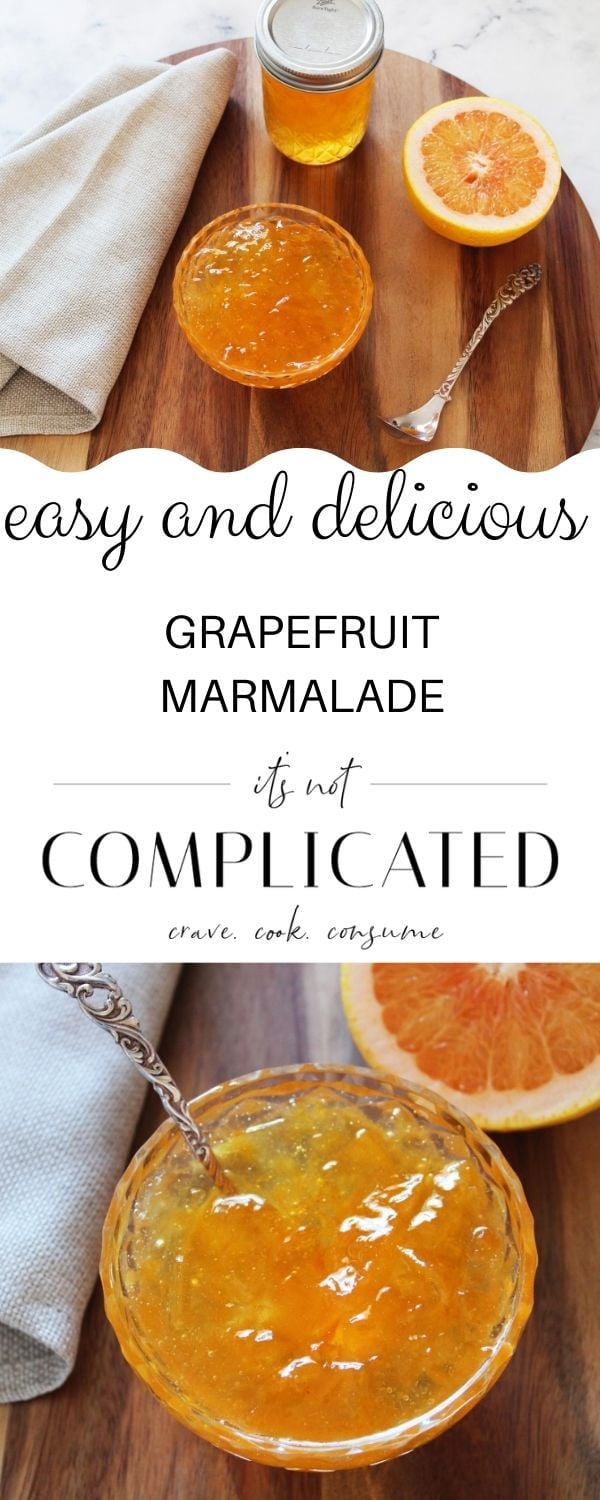

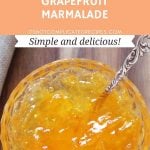

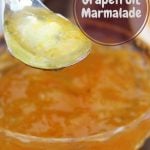
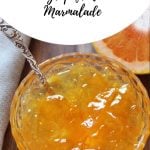
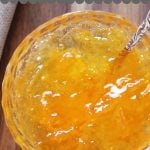
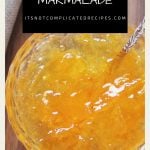
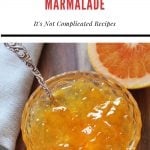
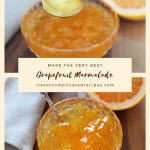


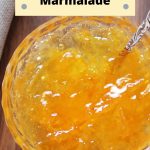
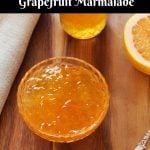
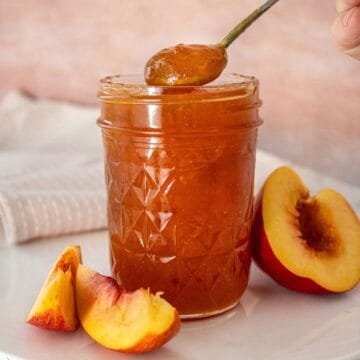
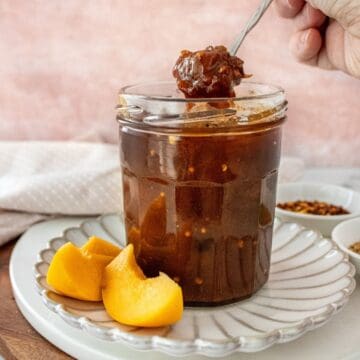
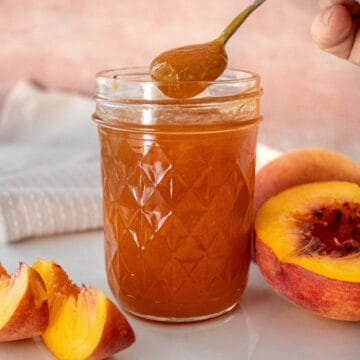
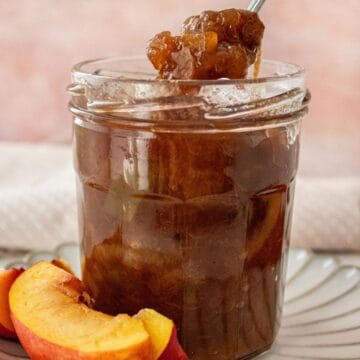
Madeline says
Thank you for the recipe, very simple to follow and I’m really pleased with my marmalade - planning to make a second batch to give as presents.
Alexandra Cook says
Thank you for making, Madeline!
I think that will make a lovely present 🙂
Appreciate your comment, Alex xo
DEBORAH ROWE says
Wonderful clear recipe.
I have made 2 lots of grapefruit marmalade and one lemon.
Alexandra Cook says
Thank you so much, Deborah! 🙂
So happy to hear this.
Alex xo
Caro says
Awesome recipe - worked a treat. Although I was naughty and only used 1.2kg of organic raw sugar and my marmalade set perfectly and is deliciously bitter 😁
Alexandra Cook says
Thanks for sharing, Caro 🙂
I am so happy it's worked well for you. Thank you for your comment and enjoy your marmalade! Alex xo
Blair says
Worked for me! 😁 delish! First time lucky or maybe just a simple recipe that if followed correctly, returns great results... Thank you! shame commenters cant include a photo of the marmelade
Alexandra Cook says
Thank you, Blair! 🙂
Happy to hear this!
Unfortunately, my website theme doesn't have the ability for photos to be shared, but if you're on Instagram or Facebook, please feel free to tag me! 🙂 I'd love to see your photo! Alex xo
Deb Newton says
Fantastic recipe I am in the process of making my second batch within a week. Won't be buying the over sweet commercial types going forward.
Alexandra Cook says
Hi Deb,
Thank you so much!
So happy to hear that you're already making a second batch 🙂
Enjoy, Alex xo
Mick Gellapingarra says
Hi l loved this recipe and l am a lover of marmalade. Had a few on my tree so made 2 batches. Worked fine and they are a great looking pantry filler.
If you have more than 2 grapefruit it’s better to back off the water quantity per recipe, you can always add it later
Alexandra Cook says
Hi Mick,
Thank you so much for giving the recipe a try 🙂
Lovely to have a grapefruit tree!
Enjoy, Alex xo
Tim B says
my digital thermometer was reading 104.5 Celsius right at this the start or most so I waited until I could do the wrinkle test on a cold plate. I think it took a bit longer, in fact quite a lot longer - maybe with the sugar added but that might have been because I originally boiled the fruit with the lid on for some of the time.
Alexandra Cook says
Hi Tim,
Hmm, that is unusual. I'm not sure if perhaps your thermometer is throwing an error? Especially once the sugar is added, the temperature would drop down quite a bit before it comes back to a rolling boil.
But yes, we don't boil the fruit initially with the lid on - the water wouldn't have evaporated as much done this way, so this is likely the reason for it taking longer to reach setting point.
Hope you'll enjoy your marmalade 🙂 Alex xo
Doug Adams says
Excellent! I was a bit sceptical on the quantities but it worked fine. I made a slight mistake in trying to rely on the wrinkle test and forgot to check the
temperature - when I did check it was well above 104.5. But it set well and tastes ideal. One tip: my grapefruit had a lot of very small pips. No problem as they came to the surface on first boiling and could be scooped off.
temperature
Alexandra Cook says
Thank you, Doug!
So happy the recipe worked out for you 🙂
Thanks for sharing your tip on the grapefruit pips also!
Enjoy your marmalade, Alex xo
Christine says
Oh my goodness complete success with this receipe! Thank you. the candy thermometer hint was a game changer for me I have always overboiled my marmalade because I was never sure about the wrinkle test but using the thermometer has given me perfect setting without over boiling and I didn’t have to wait 24 hours for it to set. And it tastes delicious!! Once again thank you
Alexandra Cook says
Hi Christine,
Thank you so much for your comment, and I am so happy to hear this!
Enjoy your marmalade, and appreciate you taking the time to let me know.
Alex xo
Cameron says
I found this recipe to be fantastic. My wife was always the preserve maker of the family, and I am now just learning my way around these recipes. This is simple to follow and produces a delicious spread. Thank you.
Alexandra Cook says
Hi Cameron,
Thank you so much for giving the recipe a try, and I am so happy to hear you had success with it 🙂
I really appreciate you taking the time to let me know.
Alex xo
Lyn says
I made this jam last week. The flavour is good but there is just too much water in this recipe. I used a temperature gauge and it was the correct temperature, I measured all the ingredients, didn't boil it too much and checked that it was thicker using a cold saucer. The first time I put it in the jars, 24 hours later it was still very runny so I took it out of the jars and boiled it again. It is now a week later and it is still too runny. I notice some people found it set and some found it didn't. I now have a lot of jars of runny nice flavoured liquid that maybe I can put in cakes or as a grapefruit flavoured dip. I wish I had used sugar with pectin in it and not so much water. Very disappointed.
Alexandra Cook says
Hello Lyn,
I am very sorry that you didn't have success with this recipe and are disappointed as a result.
I am the fifth generation to make this recipe - it is my great great grandmother's - and I can confirm that the quantities of water are correct.
I absolutely appreciate that you followed steps correctly, but it does sound as though it hadn't reached setting point initially.
When you boiled it again - did you add any additional citrus? I do recommend adding the juice of a fresh lemon to boost the pectin levels. Were your grapefruits nice and fresh when you made the marmalade? If they are older, the pectin levels will decrease.
Although this is not something I have ever done, you could try reboiling it for a third time, and add a real boost of pectin with lemon juice if this was missed last time.
I have personally never used sugar with pectin in it, and so I cannot comment on this, but some readers that prefer a very firm set marmalade have added pectin. This is a softer set marmalade - not meant to be as firm a set as commercial varieties.
Once again, I am very sorry you didn't have success. Please feel free to reach out with any queries.
Kind regards, Alex
Madeline Wagner says
So I just made this recipe and my taste before jarring it up is AMAZING. Is there no need to water bath it? Just checking. I’m only 10 minutes into my 24-48 hour wait ☺️
Alexandra Cook says
Hello Madeline,
Thank you for reaching out 🙂
For the jars, I follow the method that my great grandma used – the hot sterilised jars and the hot marmalade with the lids put on immediately cause a vacuum to form a seal as they cool. As the marmalade has just been vigorously boiled, we don’t boil it again in a water bath. The jars are shelf-stable for 12 months, and only need to be refrigerated once they have been open.
This is a method most commonly used in Australia/UK, although I am aware that in the USA/Canada water bath canning is the more popular method.
If you prefer to water bath, you certainly can, and you can find more information here.
Please feel free to reach out with any questions and enjoy your marmalade 🙂
Alex xo
Lynne Schaefer says
Thank you for such an awesome recipe. I have never made marmalade but make a lot of jam. I always thought marmalade would be hard to make. But this recipe was so detailed. I made a batch. Then I made another!!!! Cos it turned out amazing!!!!!! Love love love it. Thank you!!!
Alexandra Cook says
Hi Lynne,
Thank you for your lovely comment 🙂
So happy to hear that you have made a few batches of marmalade and are enjoying it so much.
I appreciate you letting me know! Alex xo
Josephine Clovis says
I have tried the grapefruit marmalade and I have been left with a pot full of syrup and 3 jars full. I weighed all ingredients exactly to recipe so dont understand why I have so much liquid. I am going to leave it for 48 hours and re boil with lemon as suggested. wish me luck. I am going to try the blood orange recipe tomorrow.
Alexandra Cook says
Hi Josephine,
I am not quite sure what has happened -
The syrup (once set) should still have a delicious marmalade flavour, just without the rind. (This was actually my Dad's preference!!)
Perhaps it just needed a stir in the pot before being added to the jars to distribute the rind evenly?
Please let me know how you get on, and I hope you'll enjoy the blood orange marmalade - I just enjoyed some on my toast for breakfast 🙂
Alex xo
Julie says
This recipe sounds great, I have grapefruit on a tree and was not sure what to do with it, as a side note, canning jars like Kilner should not be placed in an oven with dry heat, they are tempered to withstand high moist heat not dry, so boiling them to sterilize is best practice.
Moses Huang says
I've tried this recipe 4 times. By the fourth time, I was confident enough to wait for the tiny bubbles to appear, with the help of a thermometer. The marmalade was still runny when poured into the jars, but sure enough within 24 hours, it was set.
Alexandra Cook says
Thank you, Moses! 🙂
I am so happy to hear you've made this recipe so many times!
Appreciate your comment! Alex xo
Luisa Davies says
I live on a Greek island and presently we have a glut of amazing ,organic ruby grapefruit! I've had great success with this recipe and am thrilled every batch has turned out perfectly! I'll be offering this with pride during breakfast at our resort when the summer season starts! I'm sure many of our guests will want the recipe! I'll make sure I tell them where I got it! Thank you for a great recipe!
Alexandra Cook says
Hello Luisa 🙂
How fantastic! It's lovely to hear that your guests will be enjoying the marmalade also.
I'd love to visit the Greek Islands.. your resort sounds amazing!
Alex xo
Sarah Kearney says
This is my first really successful attempt at making marmalade. I used the sugar thermometer to determine when the marmalade had reached setting point which was a game changer - I am still enjoying the marmalade months later - it makes a lot! I will definitely be trying more of it's not complicated recipes 😁
Alexandra Cook says
Hi Sarah,
This is great to hear! 😀 Thank you so much for sharing.
So pleased you'll be trying more recipes too! Alex xo